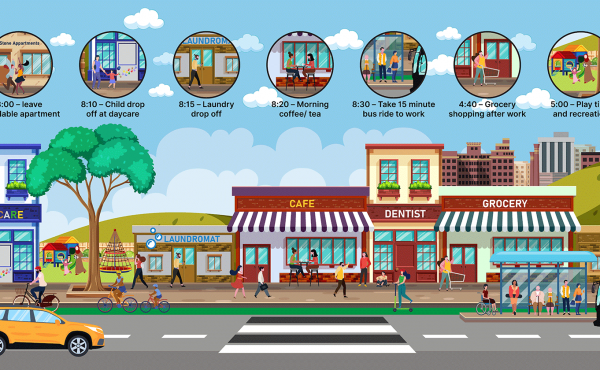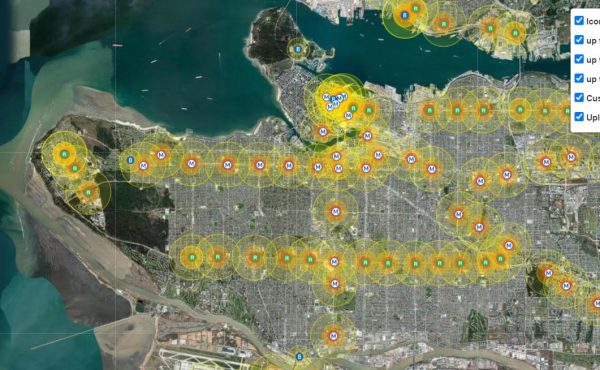

It is by no means a new idea that car travel and dependency is bad for the environment, health and a host of other derivatives. But as life goes on and the pace of change seems to only move at a crawl, it can be hard to find alternative transport methods and hang up your keys. Finding alternatives is what Transportation Transformations: Building Complete Communities and a Zero Emission Transportation System is all about. As part of the Canadian Centre for Policy Alternatives Climate Justice Project, a group of experts—Patrick Condon, Eric Doherty, Kari Dow, Marc Lee, Gordon Price—took a practical look at what transportation options exist, why they exist, and what it might take to make them better. Published just over a year ago, Transportation Transformations outlines an ambitious plan for the transformation of our transportation system that would be possible to implement within one generation, using a few simple concepts. As such, it is still extremely relevant and worth looking at more closely.
The report is broken up to look at transportation in British Columbia as it applies to different situations, from rural to urban. Living in the Lower Mainland, it is easy to forget that British Columbia is a vast area with many different community morphologies and consequently varied transportation needs. A huge metropolitan centre like Vancouver has different requirements—and solutions—than a smaller city or community like Kelowna or Smithers.
Within large urban centres, transportation alternatives are often more obvious because there are already an array of transit options available that can be expanded upon. There are existing networks of electric trolleybuses, sky trains, and bike lanes in Metro Vancouver, for example, that are slowly being expanded. These, in turn, are easier to expand because precedents within the region exist and are working.
This points to the fact that revolutionizing the transportation system does not have to mean massive undertakings in terms of infrastructure. A large part of the transformation calls for making the best use of what is available. Re-purposing roads for heavier use by transit, bike and pedestrians is a great way to increase their use, for example, and requires relatively little investment. The 2010 Olympic winter games in Vancouver were—among others—an excellent and successful precedent in re-purposing roads and existing infrastructure to move large numbers of people in and out of the downtown core.
Another pressing issue touched upon within the report is making transportation more affordable. This is consequently tied to making housing affordable. The cynical mantra “Drive until you qualify” has heavy implications for the transportation system. If affordable housing options were available closer to where people work, more transportation options become available while decreasing the strain on long-distance infrastructure.
In smaller communities and suburbs, many of the transportation challenges are similar. Often, these types of settlements first grew around compact main streets and town centres, which became less relevant after the advent of the car. Within this context, revitalizing these centres could spark a re-densification and centralization of the community. This could, and should, encourage options such as walking cycling and transit.
The creation of transit networks in these areas is another alternative. This can be a challenge, however, as transit networks in suburban and rural settings have lower ridership and are more spread out—making route planning and trip frequency difficult to maintain.
In rural regions, the challenge to go with more sustainable transportation is probably the greatest. Communities are very spread out with low populations and few options besides the car. In these areas, conventional transit models break down, but that does not mean that there is not hope. Creative solutions can be found that are dependent on the needs of the community. Amenities tend to be further apart— in different communities in some cases. This, however, could open up the potential to creating and strengthening regional bus transit systems.
Through thinking about transit differently and using what is available, transportation can be greener and more efficient for everyone. There are many excuses for not switching to alternative modes and it often seems that public policy is stuck in limbo waiting for the newest electric car. Viable options like trolleybuses are commonly more cost effective to implement than light rail, for instance. As Transportation Transformations suggests, funding such a transition could through existing sources such as carbon tax as well as the reallocation of funds from expensive freeway expansions. Large road and bridge projects are incredibly expensive to build and maintain, and only work to enable more individual car users, ultimately exacerbating the problem.
In the end, people have to choose to make alternative choices. The key is to make it an easy choice to make by creating convenient and affordable alternatives. As was learned in 2010 at the Olympics, if you build it, they will come. The Transportation Transformation report outlines strategies for easing into new transportation rhythms that are more sustainable and cost effective to implement in detail. The report includes a section on goods movement which makes up a huge portion of transportation related emissions. Co-Author Eric Doherty also teaches a seminar by the same name at Langara College which goes even deeper into the subject of sustainable transport. The next class begins on October 10th.
***
You can find the complete Transportation Transformation report here.
You can find the more information on the Transportation Transformation Class at Langara College here.
**
Andrew Cuthbert studied Geography at UVic and has worked for the provincial government and private environmental consultants as a GIS Analyst. Andrew has years of experiences working in resource extraction, seeing those industries as the basis from which almost every other industry stands spurred his interest in design and urban sustainability and planning which led to his involvement with Spacing Magazine. He has taken additional courses at BCIT, Emily Carr and Langara College to bolster his education in design and sustainability.



2 comments
Promotion of pure electric cars needs to be part of the comprehensive plan especially for rural transportation.
Terry,
Electric cars are part of what is proposed in Transportation Transformation, see page 8 for example:
“Expand regional transit options — Private electric vehicles will be a major strategy for lowering GHG emissions in rural areas. However, investments in improving low-carbon mobility options, including affordable electric passenger rail and bus services, would facilitate reduced automobile use for longer trips by both urban and rural residents.”
Battery electric vehicles should be considered in context of a low-emissions transportation and energy system. See pages 14 and 20 for more discussion of the role and limitations of electric cars.